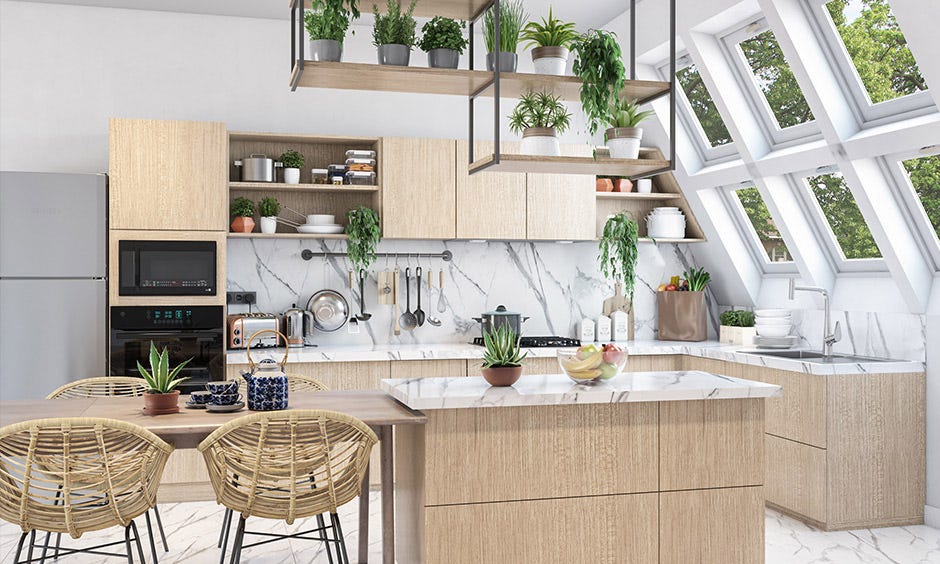In a world where environmental awareness is increasingly becoming a priority, it’s time for our kitchens to step up to the plate and embrace sustainability. Gone are the days of wasteful practices and carbon footprint neglect – it’s time to welcome the era of eco-friendly culinary spaces. From innovative appliances to conscious design choices, creating a sustainable kitchen not only benefits the planet but also elevates our cooking experiences to a whole new level. So, buckle up and get ready to embark on a journey toward a greener future as we delve into the realm of sustainable kitchen solutions – where style meets sustainability and taste meets conscience.

Green Appliances: Energy-efficient Tools for a Sustainable Kitchen
In today’s world, where environmental consciousness is becoming increasingly important, it is crucial to equip our kitchens with appliances that are both efficient and sustainable. Green appliances offer a solution by reducing energy consumption and minimizing our carbon footprint. These state-of-the-art tools are designed to save energy without compromising performance, making them the perfect addition to any eco-friendly kitchen.
When choosing green appliances, look for the ENERGY STAR label, which certifies that the product meets strict energy efficiency criteria. From refrigerators and dishwashers to stoves and microwaves, there are eco-friendly options available for every kitchen need. By investing in energy-efficient appliances, you not only contribute to a healthier environment but also save on electricity bills in the long run.
Moreover, green appliances incorporate innovative technologies such as smart sensors, auto-shutoff features, and advanced insulation, which further enhance their energy-saving capabilities. With these eco-conscious tools in your sustainable kitchen, you can actively participate in minimizing global energy consumption and help create a more sustainable future for generations to come.
Compost and Recycling Systems: Minimizing Waste in Culinary Spaces
Creating a sustainable kitchen goes beyond energy efficiency. It also involves reducing waste and adopting responsible waste management practices. Compost and recycling systems play a vital role in achieving this goal. They provide an effective means to minimize food waste and recycle packaging materials, contributing to a circular economy.
Incorporating a compost bin in your kitchen allows you to transform organic waste, such as vegetable peels and coffee grounds, into nutrient-rich soil. This compost can then be used to nourish your herb garden or potted plants, closing the loop and reducing the need for chemical fertilizers. Additionally, recycling systems help sort and separate recyclable materials, ensuring that they are properly processed and reused.
By implementing compost and recycling systems, you not only divert waste from landfills, but you also contribute to conserving natural resources and reducing greenhouse gas emissions. Such sustainable practices pave the way for a greener and more environmentally responsible lifestyle, where even our smallest actions make a significant impact.
Eco-friendly Materials: Choosing Sustainable Options for Kitchen Design
The design and construction of a sustainable kitchen require careful consideration of the materials used. Opting for eco-friendly materials not only reduces the environmental impact but also creates a healthier living space. From countertops to flooring, cabinets to paint, there are various sustainable options available that promote responsible sourcing and manufacturing.
One popular eco-friendly material is bamboo, known for its rapid renewal and high durability. It is a versatile material that can be used for countertops, cutting boards, and even utensils. Another sustainable choice is reclaimed wood, which adds character and charm to your kitchen while reducing the demand for virgin timber.
When selecting paint and finishes, look for low or zero VOC (volatile organic compound) options. These products release fewer harmful chemicals into the air, improving the indoor air quality of your kitchen. Additionally, consider using recycled or upcycled materials, such as glass or steel, to further reduce waste and promote a sustainable and stylish kitchen design.
Sustainable Cooking Practices: Tips for Reducing Environmental Impact in the Kitchen
The journey towards a sustainable kitchen extends beyond the choice of appliances and materials. It encompasses our daily cooking practices and habits. By adopting sustainable cooking practices, we can significantly reduce our environmental impact and promote a greener lifestyle.
One fundamental practice is mindful meal planning. By planning our meals in advance, we can minimize food waste, use ingredients efficiently, and shop more sustainably. Embrace seasonal and locally sourced produce, as it not only supports local farmers but also reduces carbon emissions associated with long-distance transport.
Another crucial aspect is optimizing energy use while cooking. Use lids on pots and pans to retain heat and reduce cooking time, choose the right size of burners or hob for your cookware, and make use of residual heat by turning off the stove a few minutes before the cooking process is complete. These simple steps can save energy and lower your kitchen’s carbon footprint.
Furthermore, consider incorporating plant-based meals and reducing meat consumption. Livestock production is a major contributor to greenhouse gas emissions and deforestation. By exploring vegetarian and vegan options, you support sustainable agriculture and help combat climate change.
In Retrospect
As we bid goodbye to our journey through sustainable kitchen solutions, we hope that our eco-friendly culinary spaces have sparked creativity and inspiration within you. The possibilities for creating a sustainable haven in your kitchen are endless, and we encourage you to explore even further.
Remember, every small change matters. From opting for energy-efficient appliances to utilizing reusable and compostable kitchen essentials, your choices have the power to make a significant environmental impact.
Let us embrace the beauty of sustainable practices, recognizing that a greener kitchen not only nourishes our bodies but also nurtures our planet. As we adorn our culinary spaces with earth-friendly initiatives, we are weaving the tapestry of a brighter and more sustainable future.
With each delectable meal prepared, let the love for our planet thrive. Cherish the organic ingredients, relish the simplicity of cooking from scratch, and celebrate the bountiful gifts nature bestows upon us. Let us savor the satisfaction of knowing that our culinary creations are rooted in a commitment to sustainability that extends far beyond our kitchens.
As we conclude this exploration of sustainable kitchen solutions, let us carry the torch of eco-consciousness forward, spreading the word and inspiring others to embark on this remarkable journey. Together, we can redefine the culinary landscape and shine a light on the simple choices that can make a world of difference.
So, dear readers, as you embark on your own path towards a more sustainable kitchen, remember that great things can grow from small seeds. May your culinary adventures be sprinkled with sustainable wisdom, and may your kitchen become a nurturing oasis for both you and our beloved planet.
Farewell, until we meet again, fellow guardians of sustainable culinary spaces. Keep innovating and creating, and together, let us savor a truly sustainable and eco-friendly future.

